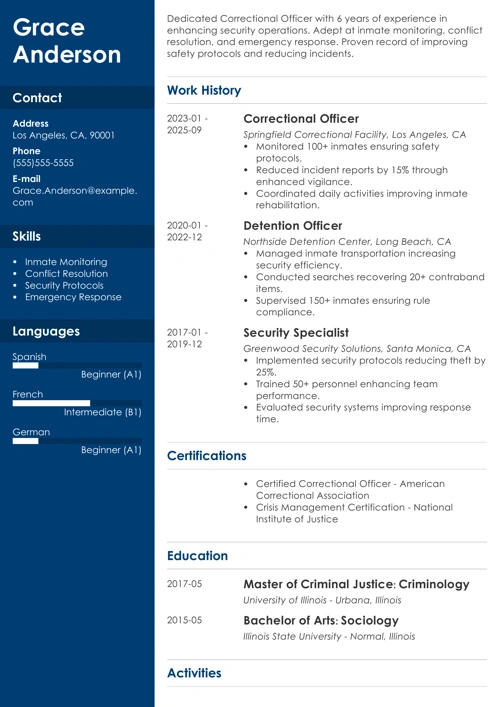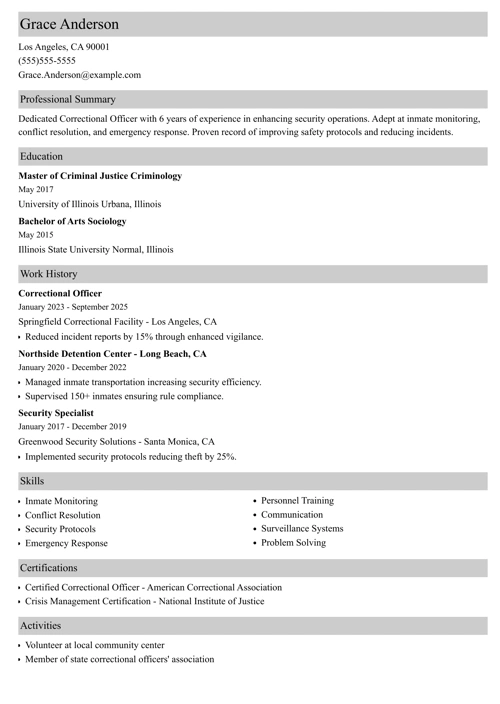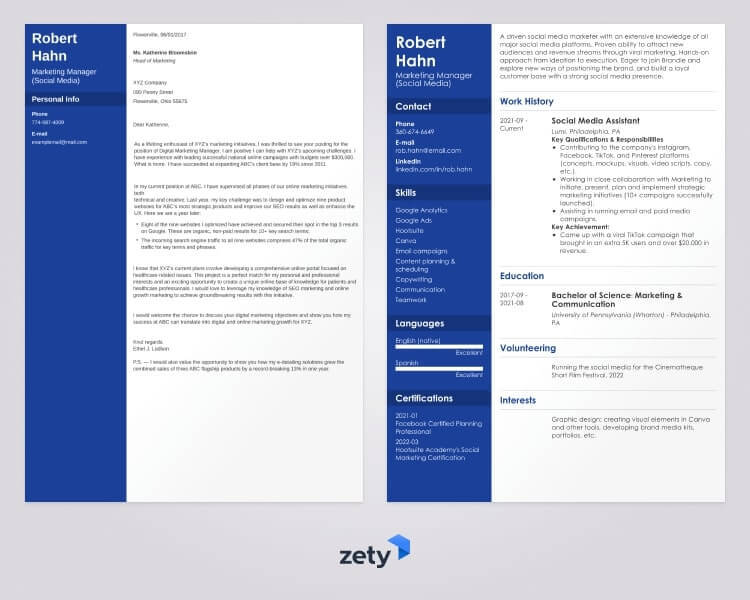Is getting the CPRW credential worth your time? Can it make you better at resume writing? This short article presents 5 takeaway resume tricks I mastered while preparing for the CPRW exam, plus a brief overview of my overall experience of becoming a Certified Professional Resume Writer.
Want to save time and have your resume ready in 5 minutes? Try our resume builder. It’s fast and easy to use. Plus, you’ll get ready-made content to add with one click. See 20+ resume templates and create your resume here.
Sample resume made with our builder—See more resume examples here.
One of our users, Brittanya, had this to say:
Zety really helped me create the best resume possible. It pointed out how things could be better on my existing resume and suggested many things to be re-worded or removed.
Becoming a Professional Resume Writer Ain’t Easy
I’ve always thought that everyone can write a resume. It’s a life skill you have to pick while stepping into adulthood. But a few years ago I realized that’s not the case. Plenty of people struggle with various aspects of creating resumes, including the content and the overall design of a job application.
When I joined Zety, I gained a deeper insight into what makes a good job application. I learned how to use different resume formats and how to write cover letters for various professions. So it was only natural that my manager encouraged me to try becoming a Certified Professional Resume Writer.
My initial reaction to this idea? I wasn’t a fan. I’ve heard that the Professional Association of Résumé Writers and Career Coaches is very strict about grading the CPRW exam. But once it was decided that our whole team will take the test, there was no turning back.
I expected the process to be a nightmare… and it wasn’t! Each exam-taker gets a study bundle that certainly helps with preparation. Plus, the association’s website features several examples of award-winning resumes that can serve as inspiration. The exam is spread over three days, and each participant must prepare a complete job application (including a resume and a cover letter) based on the candidate’s profile within that timeframe. It was challenging but in a motivating way.
After a few weeks, I received the verdict: I passed! I became a Certified Professional Resume Writer. Was it worth the effort? Definitely—I not only got the confirmation that I’m a real pro when it comes to resume writing, but I also had a chance to get even better at making the perfect resume.
Pro Tip: If you decide to register for the exam, you’ll have one year to complete the process. So there’s still plenty of time to study the materials and prepare yourself. Plus, if you don’t succeed the first time, you can re-take the exam!
Resume Tricks I Mastered Through the CPRW Exam
There is no one-size-fits-all resume. Every job application is different. But when you write dozens of resumes monthly, it’s easy to fall into a habit of picking the easiest way out. It’s worth reminding yourself about various resume-writing principles from time to time. And the preparation for CPRW credentials is a good opportunity to do that.
Here are the key resume-writing tips that are worth mastering:
1. Choose the Resume Format That Suits the Candidate
You’ve probably heard again and again that the only resume format that hiring managers like is the chronological one. But it’s not a cookie-cutter solution for all job applicants. The functional resume format and the hybrid resume exist for a reason—sometimes, they’re just better suited for the candidate.
Before starting a resume, consider the style you want to follow. It’s perfectly fine to use a skill-based resume or a combination resume format, as long as they highlight relevant information and are compatible with ATS systems.
2. Make All Elements of Resume Design Consistent
A professional resume certainly doesn’t have to look boring. I’m very visually oriented, and I love playing around with layouts and document formatting. This makes me pretty good at creating job applications that not only sound great but also look impressive. However, striking the right balance between the form and the function is key. I have a tendency to overdo things: use several different fonts, a few colors, and different styles of bullet points—and that’s not the best approach.
It’s much better to keep all the elements of the resume template consistent. If you want more than one resume font, stick to two maximum. Colors? Black or dark gray for the majority of the contents, and one dominant color for the header or section headings. Less is more—that’s why minimalist resume templates are so popular.
3. List Core Competencies Under the Resume Profile
It’s not a mystery that the upper half of the resume attracts the most attention. So why not use this part to insert a handful of resume keywords? A core competencies section is a great way to do that. Just include the key skills relevant to the position you want. You can list them using bullet points, or write them one by one in a paragraph and separate them with a hyphen or another symbol. This will not only help to make your resume ATS-friendly but also grasp the hiring manager’s attention.
4. Don’t Limit Yourself to Just One Page
You’ve probably heard that recruiters won’t look beyond the first page of a resume. It’s only partially true. One-page resumes are standard for job applicants who don’t have extensive professional experience, as well as in creative industries where a resume usually accompanies a portfolio. But if you feel that your relevant experience can’t be trimmed down to fit one page, don’t force it.
Two-page resumes are perfectly good—just make sure that all the information you’re serving is there for a reason. Don’t go beyond one page if all you have to add are unnecessary fillers.
5. Pay Attention to Math and Numbers
This may sound scary but it’s the truth: math is important on a resume. Numbers make professional achievements pop. However, not all numbers are equally impressive. Compare:
- Increased website traffic by 250%.
- Increased website traffic by 500 visits daily.
and:
- Saved $84,000 within a year through outsourcing efforts.
- Saved 0.5% of the yearly budget through outsourcing efforts.
Notice the difference? When describing accomplishments, think carefully about numbers, and show the ones that make your achievements more impressive.
Maybe you’d like to brush up on your knowledge of resume writing? Check these useful guides:
- Writing Resume Job Descriptions
- What's a Winning Resume?
- Showing Skill Levels on a Resume
- How to Write a Resume Summary
- Resume Education Section
Plus, a great cover letter that matches your resume will give you an advantage over other candidates. You can write it in our cover letter builder here. Here's what it may look like:
See more cover letter templates and start writing.
About Zety’s Editorial Process
This article has been reviewed by our editorial team to make sure it follows Zety's editorial guidelines. We’re committed to sharing our expertise and giving you trustworthy career advice tailored to your needs. High-quality content is what brings over 40 million readers to our site every year. But we don't stop there. Our team conducts original research to understand the job market better, and we pride ourselves on being quoted by top universities and prime media outlets from around the world.



